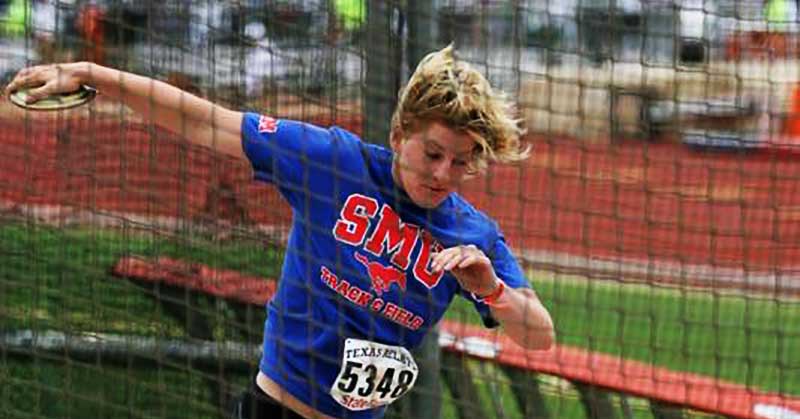
Most people picture a large, overweight athlete as the ideal or the norm for the shot put, hammer, discus, and weight throw. Yet, when I interviewed people for this story, including former Olympians, in nearly every case they also coached the throws, and most said that what they look for in a thrower is a tall, rangy athlete.
Some people think that a woman hammer thrower has to be a big, muscular woman. Sure, Tatyana Lysenta is No. 3 and Aksana Miankova is No. 4 in the world and both are about six-feet tall and weigh 180 pounds or less. However, Gulfiya Khanafeyeva is the seventh best hammer thrower in history and she was 5’8” and 150 pounds. Yelena (Priyma) Rigert of Russia was 5’5.5” and 139 pounds when she competed, and her top throw is still ranked in the Top 25. So, while being tall does help, all of the top women throwers are athletic regardless of their size.
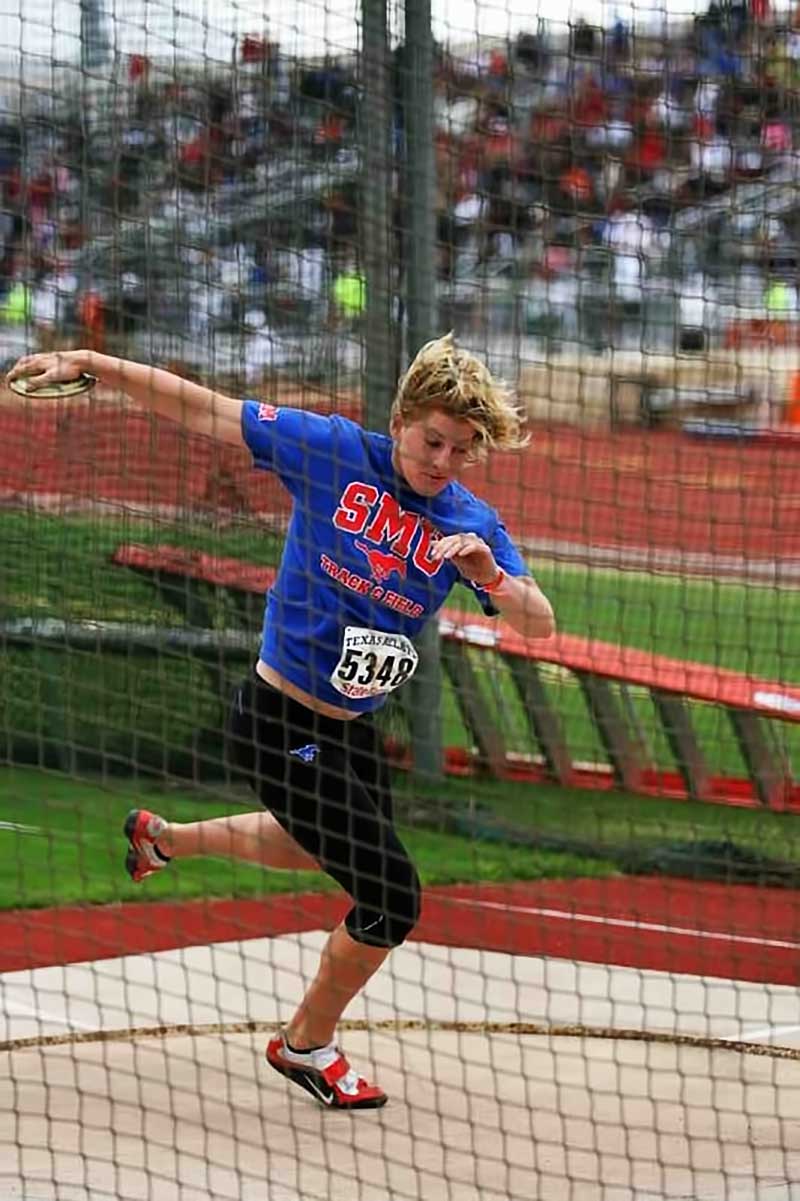
An important thing to keep in mind for women in these events is that their implements do not weigh as much as the men’s. Therefore, there is more of a premium on athletic ability, speed, and technique than in the men’s events. At the Olympic level you do have to be strong, but fat can actually be detrimental because it will just slow you down. At the lower levels of competition, you will see all types of bodies that work in the throwing events.
Throwers aren’t just big people that can’t run; it is quite the opposite, actually. ~Aubrey Baxter
I spoke with several female coaches and trainers with experience as throwers, as well as the father of a successful current high school thrower. We discussed the need to dispel misconceptions about female throwers, ideas on how to make the sport more popular and attractive to spectators, and how to get more girls involved.
Aubrey Baxter
Aubrey Baxter was born and raised in Redfield, SD. She was a decorated four-sport athlete in high school (track and field, volleyball, basketball, and softball). After graduating in 2004, she played college volleyball and competed in track and field for a year, and then decided after the season she would focus solely on track and field. She graduated with a bachelor’s degree from Black Hills State University in 2009 with a Psychology major and Sociology minor.
Altogether, Baxter is a 27-time All-American, and has won 15 National Championships (8 NAIA Titles at Black Hills State University and 7 USATF Club National Titles). The discus throw was her weakest event, as she tossed it “only” 169’5”.
Baxter competed in the 2016 U.S. Olympic Trials and finished in seventh place in the hammer throw, with a throw of 219’10” or 67.01 meters. She is also an applied technology specialist at Metropolitan Community College, a personal trainer with Nebraska Elite, an independent beauty consultant with Younique, and a life coach. She is married and has one son.
Bill Peyton: What things should a high school kid not do in training to be a discus thrower?
Aubrey Baxter: I don’t think kids should focus on what not to do, but instead on what they should do. Throwers aren’t just big people that can’t run; it is quite the opposite, actually. To be a successful thrower, you need to be an athlete. Every thrower needs to work on technique, strength, speed, and power, among other things.
BP: What things should a thrower do that will aid in their development?
AB: When I was younger, I went to a few throwing camps. The big one I went to was out in Custer, SD, which really showed me the possibilities that were available for me if I continued throwing. Going to camps, connecting with other throwers and coaches, being a student of your event—there are so many things that can aid someone in their development, along with the obvious one of working hard.
BP: How do you convince a girl to become a thrower and, just as importantly, how to
have the courage to stay with it?
AB: When I was younger, I struggled with my size. I hated how wide my shoulders were and I really struggled with it. However, if someone would have asked me what I wanted to be when I was older, I would have said a professional athlete. I wish I would have had someone like me say, “Well, that’s why you have wide shoulders, so that you can achieve that dream of yours.” My family and friends were great, but I needed someone like I am now to say that to me then.
Along with working at Metropolitan Community College, personal training at Nebraska Elite, training myself, and being a mother, I also do coaching and self-esteem training with young girls. I help girls figure out what they are passionate about. If it’s not throwing or track that’s totally fine, but I want them to find what they are passionate about and focus on positive things about themselves instead of negatives.
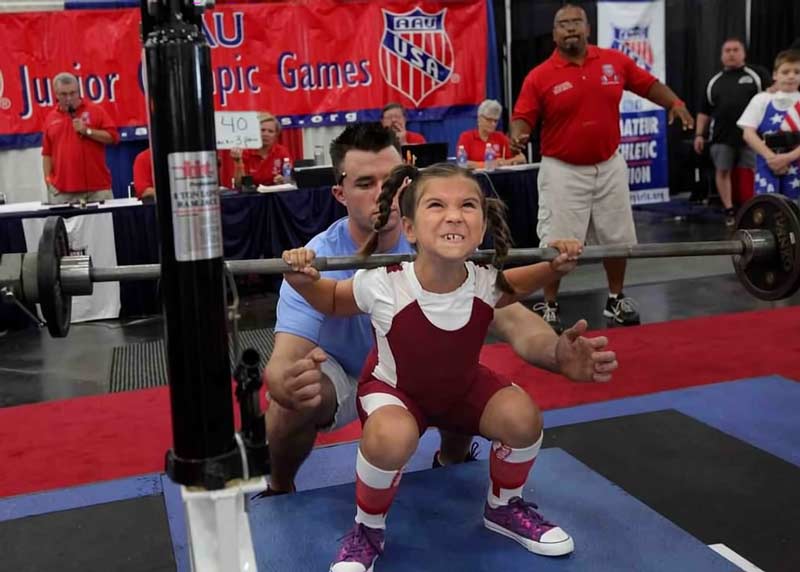
BP: How can we get athletic women to become hammer throwers and to have the courage to stay with the event?
AB: I think if young girls see elite hammer throwers compete, they will want to do it too; especially the competitive, driven, and strong young ladies. The hammer throw is such an incredibly beautiful event that takes strength, power, technique, patience, hard work, time, etc.
Coach Bob McKay, the former U.S. Olympic Developmental Coach, told me that when Lance Deal, 1996 Olympic Silver Medalist, handed someone a hammer for the first time, he said, “Welcome to frustration.” This is so true. It’s the event that you have to go fast in, but be patient; you have to throw the ball in, but let it carry you. It’s maddening! But at the same time, it’s beautiful and so much fun to do. I think if people watch elite hammer throwers compete, they will see how amazing the event and the athletes that do it are.
BP: What might surprise people about throwing in track and field?
AB: I don’t know if this would surprise people or not—definitely not throwers—but I think the progression of all of the throws is beautiful. It’s amazing to break down throws into the path the implement travels and that feeling of an effortless throw. It’s beautiful.
BP: How can we make throwing in general more popular?
AB: In order to make throwing more popular, we need to be seen. Throwers need to be focused on (along with field events in general). If some of our stories got out, I think we would have a lot bigger following. But no one knows who we are because we are never covered by the media. I wish that the amazing people who compete for this country (I am biased toward throwers, of course) would be showcased and supported more because they deserve it.
BP: I’m hearing people say to put the throwing events inside the track. You have seen more top-level track meets than I have. With artificial turf, potential injuries, and other issues, how do we do this?
AB: I know that throwing on the infield would help, but yes, there are safety concerns there. I think the biggest thing is for the media to step in. Showcase throwers, share their stories, and people will fall in love. Throwers are a different breed, but I have had some of my best memories being around throwers. They love what they do, they are passionate, they are a little crazy, but they are usually a blast to be around.
BP: Both boys and girls go into the throws as something to do between seasons. They do not take it seriously. The money goes to football. Do you have any suggestions?
AB: Sadly, this is very much a reality. I can see this as being a negative, but at the same time, a positive. Yes, we lose many athletes to other sports because they are more popular than track and field, and that is too bad. I feel like we, USATF, the media—everyone has to do their part in sharing how amazing throwing events and the athletes that throw are. We go outside and throw things as far as we can, that’s awesome! The positive to losing some athletes to other sports is that we are left with the people that really do love throwing, and that creates an amazing atmosphere when you get a group of throwers together.
BP: Are throwing events emphasized enough at the grassroots levels?
AB: You have to be very careful with young kids when it comes to the throwing events. The hammer is an event that most people pick up later in their careers as throwers.
I had no idea what the hammer throw was before my freshman year of college; absolutely no clue at all. I have been part of numerous camps that try to teach young throwers the opportunities that are available to them if they work hard and stick to it.
Megan Schuessler Young
BP: Tell me about your own background in the throws. Include your childhood sports, reasons why you got involved with throwing events, best marks, and titles won, if any.
Megan Schuessler Young: I started throwing in the seventh grade when track season rolled around. Being a bigger, powerful girl, the throws were where my coaches guided me when choosing a field event.
Luckily, I had coaches that I liked and that liked me and I enjoyed the challenge of throwing, so I stuck with it. I grew up in the small town of Llano in the middle of Texas. As a kid, I played just about everything my town offered. My mom taught me tennis and my dad taught me softball/baseball and those were the two first sports I learned.
I took swimming lessons for long as I can remember and, though we didn’t have a competitive swim team, I really enjoyed swimming. I started playing basketball in second grade when they allowed us to sign up for Little Dribblers. I also did random activities at the local fitness center like gymnastics, ballet, and taekwondo. We didn’t have volleyball or soccer, so I never got to experience those sports that seem so popular now.
I don’t think I won any major titles. I was the high school district champion several times in shot put and in discus, but nothing in college. I did hold both my high school and the Texas Tech school records in the discus, but they were both quickly broken. My best marks (which took some Googling) were 46’9.5” in the shot put and 169’3” in the discus.
BP: How can we get more girls interested in the throwing events at the grassroots level and then help them have the courage to stick with it through their growing years?
MSY: I think that a lot of it starts with the parents. Parents are the ones who decide what their children will do; at least when they first start participating in activities. If parents have never been exposed to throwing or have a negative association with it, then they will not steer their children towards it.
For girls, throwing being thought of as “manly” seems be the biggest hurdle. This is an issue especially for middle school girls, which is when most girls first experience track and field. They are so concerned with how they look and how others perceive them. Changing that perception is a big key to getting girls to try and stick with throws.
Changing the perception of female throwers as “manly” is a key to getting girls to try throwing. Share on XI think if there was a way to get parents and families out to watch track meets, and for young girls to see how graceful and powerful elite level throwers are, they might be more inclined to throw. This might also help girls to see that throwers are not typically the big slow girls who are throwing because they cannot do anything else, but are really exceptional athletes doing very difficult movements in a powerful way.
Convincing parents of the merits of track and field on their child’s athletic development could also be helpful. I hear all the time that, “I put my kid in (blank) so they can improve their (blank).” You could fill in the blanks with just about any skill and any sport, such as soccer for agility or football for power.
The beauty of track and field is that is has the potential to teach and allow kids to practice an enormous array of skills in a one-stop shop. If parents could see that, I think they would be more likely to sign their kids up for track earlier and therefore instill in them a feeling for “I do track” that’s like the way most of the kids that I work with feel about soccer, softball, and volleyball. As a side bonus, they might actually learn to run correctly at an early age, which will benefit them for every sport down the road, and develop a mental toughness that could also help them in all sports, and in life in general.
Youth track and field also should become elite. In my experience, summer track and track clubs are a “you-pay, you-join system.” Track and field is just happy to have people interested. However, as seen with the AAU basketball, club soccer, and travel softball teams, etc., the harder it is to get into something and the more it costs, the more people want to do it and the more invested they are in it. If a parent pays $3,000 for a club sport and the kid has to try out to even make the team, then, by golly, that kid is going to every practice and game and will do so with a smile on their face. If a parent pays a minimal fee and their kid gets to compete no matter what, who cares?
On the flip side of that, it takes a special person to be a thrower. It is not for everyone and kids should not be forced into it or they will hate it. However, if a girl does like to throw, having parents and coaches who are encouraging and supportive is good for helping a girl to keep throwing during her growing years.
BP: Is there a way we could get the throwing events inside track and field stadiums or at least nearby?
MSY: With younger children, I am OK with field events being outside the track. You never know where the implement is going to go, and with the already cramped time schedule, it would be almost impossible to schedule throwing events when there aren’t running events going on.
I do think it helps the atmosphere of the throws when there are more people watching. The reality is that, if the throws area is outside the track, the average track fan is not going to miss everything else going on at the track to go watch throws.
BP: There are a few isolated smaller events where the throws are featured. (I am thinking of the Golden League.) However, the organizing groups seem to be against this type of thing. Do you think we should pursue shorter, more concentrated meets?
MSY: I think anytime we can have meets that are advertised and made to be entertaining and exciting, it’s a good thing for track and field in general. People have short attention spans and some people will balk at taking their families for an entire day or night of track and field.
I do like the idea of shorter, more focused events, especially out in public places like the shot put in downtown Lawrence for the Kansas Relays or pole vaulting in the mall for the Drake Relays. The more everyday people who know nothing about track and field can be exposed to it, even by accident, the easier it is for kids to get excited about track.
BP: A key to getting girls involved with throwing events, and athletics in general, may be to develop, hire, and maintain women coaches. Is there a way we could do this well?
I don’t think it matters if a coach is male or female. What matters is how educated and enthusiastic they are about coaching the throws. ~Megan Schuessler Young
MSY: I don’t think it matters if a coach is male or female. What matters is how educated and enthusiastic they are about coaching the throws. The job of throws coaching in middle or high school is often given to a coach, whether they want it or not and even if they know nothing about it. But even then, a coach who is willing to learn and who shows up every day to practice eager to help his or her athletes get better is what young athletes need.
A coach who is just “getting through” track season is not helpful for the progression of the athletes or the sport. There has to be better education for throws coaches. Throwing is such a complicated event to coach and not many people put the time they really should into learning how to coach it.
Ramona Pagel
Ramona Pagel was born in Los Angeles, CA, and married Kent Pagel, a former UCLA thrower. He coached her throughout much of her career. She graduated from Long Beach State University in 1982 and San Diego State University in 1984. After leaving SDSU, Pagel made four consecutive Olympic teams, 1984–1996, in the shot put.
Pagel held the American record in the shot put for 25 years and also spent eight years on the Top Ten list for Americans in discus, until back problems caused her to choose to focus on her best event. She currently works as the Wellness Director with the U.S. Navy NBVC. She also worked as a coach for 28 years at the collegiate level.
Personal Bests:
Shot Put: 66’2.5”; 20.18m
Discus: 203’2”; 61.92m
Javelin: 150’2”; 45.77m
BP: How can we get more girls interested in the throwing events at the grassroots level and then help them have the courage to stick with it through their growing years?
Ramona Pagel: It would be easier for the women to use a lighter shot put in high school. The men go from 12-16 pounds, whereas the women use a 4kg as a 14- or 15-year-old and on up. A 3kg or 3.5kg for girls in high school would allow them to learn the technique without being intimidated by the weight.
BP: Is there a way we could get the throwing events inside track and field stadiums or at least nearby?
RP: Only if we eliminate football and soccer. The cost of grooming infields and the ability of schools to rent out their fields is precluding our use of the turf field. Better understanding of the events by announcers or having an announcer at the events that are out of sight would help.
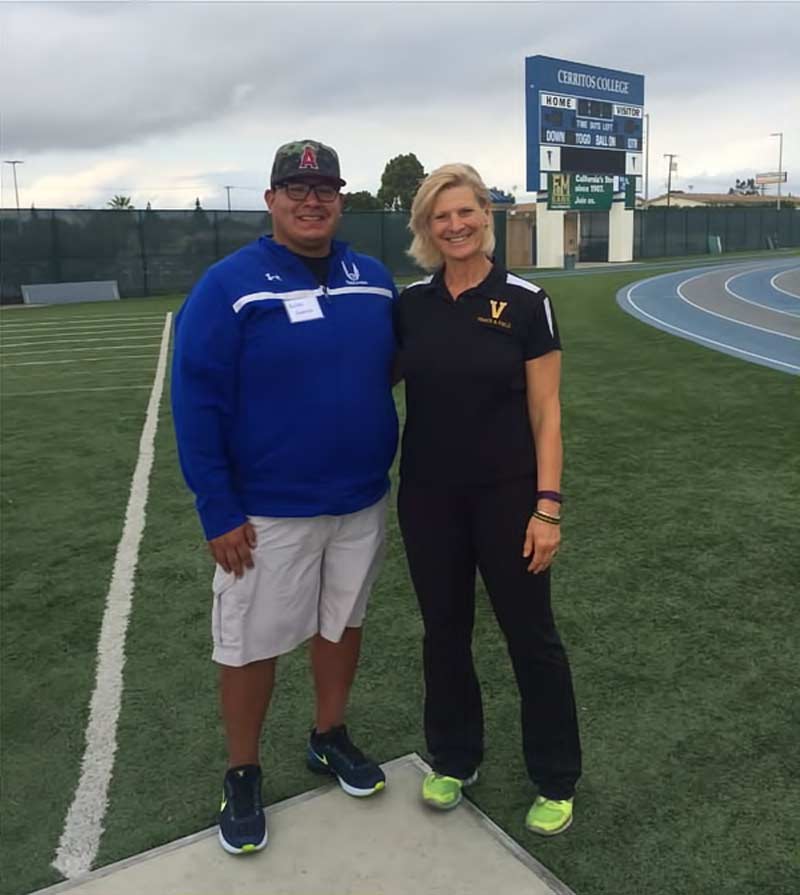
BP: There are a few isolated smaller events where the throws are featured. (I am thinking of the Golden League.) However, the organizing groups seem to be against this type of thing. Do you think we should pursue shorter, more concentrated meets?
RP: Meet directors are influenced by an athlete’s marketability and much of that involves changing the public’s perception of throwing events, as compared to more popular events like football games.
BP: A key to getting girls involved with throwing events and athletics in general is to develop, hire, and maintain women coaches. Is there a way we could do this well?
RP: More women coaches would be great. There seems to be more pressure to perform as a female coach, as they always have to do better than the male coaches, for less pay. High school coaches do not get paid much for coaching, so it becomes a passion profession.
College track and field coaches are paid on the lowest scale, and rarely is a throwing coach considered for a head coach position. So pay for the most part is at entry level. I see many good coaches go into administration because, once they have a family, the hours are regular and they get paid more. It does not make sense, but the change will have to start with knowledge on the part of administrators and hiring committees.
Cathy Casey
Cathy Casey is in her 14th year (2002–present) at SMU, and is the head coach for the school’s cross country and track and field programs. She became the head cross country coach in 2005 and the head track and field coach in 2015.
Casey has played a pivotal role in the Mustangs’ swift rise to national prominence in cross country, winning five Conference championships (four C-USA and one American Athletic Conference) in the last seven years. During each of the championship seasons, she earned Coach of the Year honors. On the track, Casey specializes in the development of middle- and long-distance athletes.
She is native of Carbondale, Illinois, and was a member of the cross country/track and field team at the University of Texas, earning her degree in 1997. Casey currently resides in Dallas, TX, with her husband.
BP: How do you get athletic women to try the discus throw and, even more importantly,
have the courage to stay with it?
Cathy Casey: I think that we need more former throwers to coach our youth—female throwers in particular—to make sure the girls know that throwing is an option for them. We lose these kids to other sports like volleyball and basketball simply because these girls just don’t know how good they can be at throwing. With a technically sound coach, they will keep improving and therefore can have the confidence to continue with the event.
We need more former throwers to coach our youth—female throwers in particular—to make sure the girls know that throwing is an option for them. ~Cathy Casey
BP: How can we make throwing events more popular? The running and jumping events seem to be much more popular.
CC: I think that the throwing events can be made more popular by incorporating the throwing area at the track. Too many times, they are outside the main venue so that no one can see the throwers compete. Put on more throwing clinics and coaching education classes for throws. Put pressure on high schools to hire coaches with a track background.
Elizabeth Murphy
Elizabeth Murphy finished her first year as the SMU Track and Field Throws Coach in 2016. This was Murphy’s first step into coaching, after competing as a thrower as a graduate student at SMU and three years previously at Grand Valley State University.
Murphy returns to the Hilltop after competing in the weight throw and hammer throw for SMU in 2012–13, winning the Conference USA Outdoor Championship in the hammer throw and coming in third at the C-USA Indoor Championships in the weight throw. Those results, along with a 16th place finish at the NCAA Championships, earned her All-American status in her only year at SMU.
Prior to her time at SMU, Murphy was a two-time hammer throw champion and six-time All-American at the Division II level while at Grand Valley State. She also holds the record at the D-II level in the weight throw for indoor track and field.
BP: How do you get athletic women to try the discus throw and, even more importantly, have the courage to stay with it?
Elizabeth Murphy: I think most women start out trying the throwing events, in general, as an auxiliary sport. For example, basketball players decide to run track in the off-season to stay in shape. Some of the bigger girls on the basketball team end up throwing and being decent at it. I’m sure there are a handful of girls who want to be “throwers” and I’m sure, internationally, there are more women who want to be throwers than in the U.S.
If we want to talk specifically about discus, that’s probably one of the easier events to get women to throw. I’ve heard people describe the discus as “pretty,” so it is easy to understand why a woman would be more likely to throw discus rather than shot put. I feel like discus sheds the masculinity that is associated with shot put and that’s why more women gravitate towards disc than shot.
BP: How can we make throwing events more popular? The running and jumping events seem to be much more popular.
EM: I believe the unpopularity of the throwing events is an effect of a bigger problem. Our society doesn’t want to see women in a muscular state. These views are changing slightly, but they haven’t shifted enough to be accepting of different body types than what would be viewed as “ideal” for women.
The unpopularity of women’s throwing events is an effect of society’s views of “ideal” body type. Share on XIf I am going to be completely honest, when someone thinks of a female “thrower” they think of Mrs. Trunchbull from the movie Matilda, or they think of a woman who is of above-average size. Neither of these views is appealing to society, nor are they accepted by society. We need to change what is viewed as “normal” to encompass the growing athletic arena for women. I know you asked specifically about throwing events, but I believe this is related to most women’s sports.
Beth-el Algarin
I attended the Minnesota Section 5A meet at St. John’s University in Collegeville, MN, in early June. Beth-el Algarin was throwing the shot put for Pierz Healy High School, and she won that event along with the discus throw the same day. It was hard not to be intrigued by this little dynamo with the white shot put. Even to someone who does not know the throws that well, it was easy to see that she was much quicker than the other throwers. Algarin was the shortest and probably the lightest person in the finals.
I had the opportunity to listen to a person I thought was her coach. He had something to say to her after every throw and they both seemed to be having a lot of fun. It was obvious that Algarin was happy with her last throw, as she whooped it up and celebrated with the “coach,” who actually turned out to be her father, Luis Algarin. The throw was a personal record for her at 42’6”.
Mr. Algarin volunteered some information about his daughter, as it must have been obvious I was intrigued by her throwing. “She has been winning world powerlifting competitions since she was eight years old,” he said. “However, she started out with very light weights until she got a bit older. She can now bench press 275 pounds.”
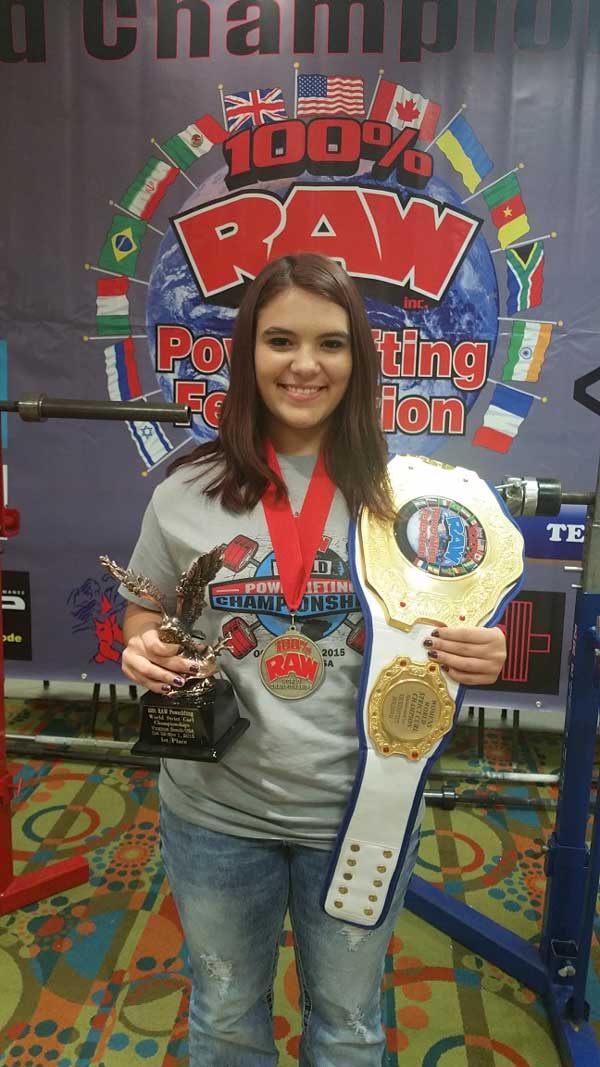
It seemed that, although he was happy with how she performed at Sections, he just knew her potential was much higher. I asked him about his own athletic participation and he told me that he had once bench pressed 600 pounds in college!
Luis Algarin is the state chairman for one of the largest powerlifting federations in the world. So he is the main influence for Beth-el Algarin getting into the weight room and the record books. She holds 70-plus world records in various age and weight groups.
“She has tried to put her power to work in the throws, but it takes more than brute strength (as we have come to learn). Bottom line, strength is great, but technique is everything,” said Mr. Algarin.
Throws take more than brute strength. While strength is great, technique is everything. Share on XBeth-el Algarin was a distance runner in cross country and track and field, while competing in world championship events in powerlifting. She won the conference championship in the 800-meter run as a seventh grader. She would still be running long-distance races if not for injuries to her knees.
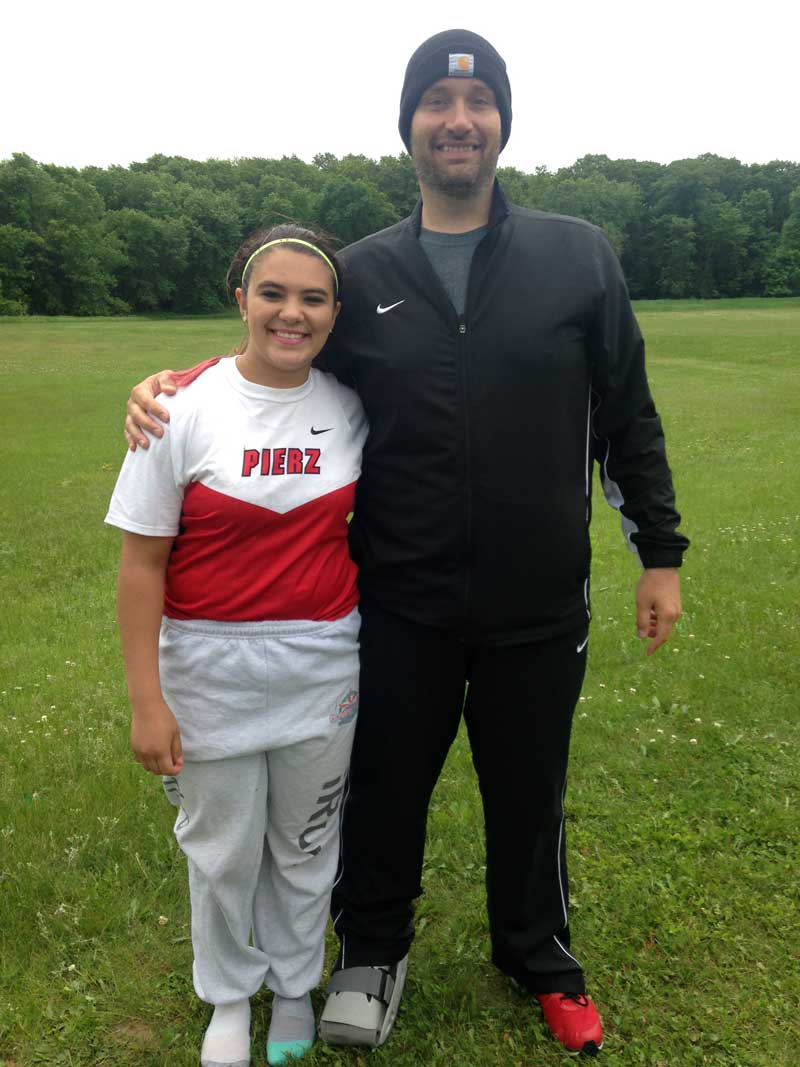
The next week at the state meet, Beth-el Algarin finished in third place in the shot put at the State Class A meet with a throw of 41’1.5”. She was 1.5 inches away from second place.
Since you’re here…
…we have a small favor to ask. More people are reading SimpliFaster than ever, and each week we bring you compelling content from coaches, sport scientists, and physiotherapists who are devoted to building better athletes. Please take a moment to share the articles on social media, engage the authors with questions and comments below, and link to articles when appropriate if you have a blog or participate on forums of related topics. — SF
Reference:
Beckham, Jeff. “There’s More to Shot Put Than ‘Beastly Women.’” Wired. August 6, 2012.


Awesome article Bill! Wished it was longer.
Hello, my name is Kevin Dreyer and I found this article to be absolutely amazing, but I agree with the above comment as I wish I could read on! This was a very good blog and I will be showing the many female throwers that I coach about how this inspired me to look at women in throwing differently.